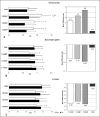Optimizing Short Sprint Interval Training for Young Soccer Players: Unveiling Optimal Rest Distributions to Maximize Physiological Adaptations
- PMID: 38841640
- PMCID: PMC11149070
- DOI: 10.52082/jssm.2024.475
Optimizing Short Sprint Interval Training for Young Soccer Players: Unveiling Optimal Rest Distributions to Maximize Physiological Adaptations
Abstract
Present study aimed to compare the effects of SSIT intervention with varying rest distributions on hormonal, physiological, and performance adaptations in soccer players. Thirty-six players were randomly divided into three SSIT groups, each performing 4 sets of 6-10 repetitions of 6-second all-out running with rest intervals at ratios of 1:3, 1:6, and 1:9. Prior to and following the 7-week training period, aerobic fitness indices and anaerobic power were evaluated using a graded exercise test with a gas collection system and a lower-body Wingate test, respectively. Also, sport-specific bio-motor abilities were determined by measuring vertical jump, 20-m sprint, and T-test change of direction speed, Yo-Yo IR1 and maximal kicking distance. Hormonal status was also monitored by evaluating testosterone and cortisol levels. Following the 7-week training period, all SSIT interventions resulted in significant enhancements (p < 0.05) in soccer-related performance, physiological parameters, and hormonal adaptations, exhibiting effect sizes that ranged from small to large. Comparative analysis indicated that the 1:9 SSIT results in greater adaptive responses (p < 0.05) in the vertical jump, peak power, testosterone, and cortisol compared to the 1:3 SSIT group. By contrast, the 1:3 SSIT group induced more adaptive responses (p < 0.05) in the mean power output, maximum oxygen consumption (V̇O2max), and Yo-Yo IR1 compared to the 1:9 SSIT group. Hence, for enhancing physical performance, especially vertical jump height, anaerobic peak power, and hormonal adaptations, the 1:9 SSIT ratio is preferable. Conversely, shorter rest intervals (specifically, the 1:3 SSIT ratio) are better suited for eliciting heightened adaptive responses in mean power output, V̇O2max, and Yo-Yo IR1 over the 7-week training period among young male soccer players.
Keywords: Sprint interval training; aerobic capacity; metabolic conditioning; power.
© Journal of Sports Science and Medicine.
Figures






Similar articles
-
Effects of Short Sprint Interval Training Frequency on Physical and Physiological Performance Adaptations in Male Soccer Players.J Sports Sci Med. 2024 Dec 1;23(4):707-717. doi: 10.52082/jssm.2024.707. eCollection 2024 Dec. J Sports Sci Med. 2024. PMID: 39649571 Free PMC article. Clinical Trial.
-
Physiological and Performance Adaptations to Varying Rest Distributions During Short Sprint Interval Training Trials in Female Volleyball Players: A Comparative Analysis of Interindividual Variability.Int J Sports Physiol Perform. 2024 Aug 14;19(10):1048-1057. doi: 10.1123/ijspp.2024-0104. Print 2024 Oct 1. Int J Sports Physiol Perform. 2024. PMID: 39142642 Clinical Trial.
-
Effects of Sprint Interval Training Surface on Physical Fitness Attributes of Collegiate Female Soccer Players: Identifying Individual Responses to Training on Grass, Sand, and Land Surfaces.J Sports Sci Med. 2024 Jun 1;23(2):465-474. doi: 10.52082/jssm.2024.465. eCollection 2024 Jun. J Sports Sci Med. 2024. PMID: 38841634 Free PMC article. Clinical Trial.
-
Gender-Specific Effects of Short Sprint Interval Training on Aerobic and Anaerobic Capacities in Basketball Players: A Randomized Controlled Trial.J Sports Sci Med. 2024 Mar 1;23(1):8-16. doi: 10.52082/jssm.2024.8. eCollection 2024 Mar. J Sports Sci Med. 2024. PMID: 38455442 Free PMC article. Clinical Trial.
-
The Effects of High-Intensity Interval Training on Basketball Players: A Systematic Review and Meta-Analysis.J Sports Sci Med. 2025 Mar 1;24(1):31-51. doi: 10.52082/jssm.2025.31. eCollection 2025 Mar. J Sports Sci Med. 2025. PMID: 40046212 Free PMC article.
Cited by
-
Effects of Short Sprint Interval Training Frequency on Physical and Physiological Performance Adaptations in Male Soccer Players.J Sports Sci Med. 2024 Dec 1;23(4):707-717. doi: 10.52082/jssm.2024.707. eCollection 2024 Dec. J Sports Sci Med. 2024. PMID: 39649571 Free PMC article. Clinical Trial.
-
Circulating growth hormone, cortisol and testosterone in relation to vitamin D status: influence of lower and upper body wingate anaerobic test in elite artistic gymnasts.BMC Sports Sci Med Rehabil. 2025 Aug 27;17(1):252. doi: 10.1186/s13102-025-01291-3. BMC Sports Sci Med Rehabil. 2025. PMID: 40867001 Free PMC article.
References
-
- Ambroży T., Rydzik Ł., Obmiński Z., Błach W., Błach B. (2021) The effect of high-intensity interval training periods on morning serum testosterone and cortisol levels and physical fitness in men aged 35-40 years. Journal of Clinical Medicine 10, 2143. https://doi.org/10.3390/jcm10102143 10.3390/jcm10102143 - DOI - PMC - PubMed
-
- Arazi H., Asadi A., Khalkhali F., Boullosa D., Hackney A. C., Granacher U., Zouhal H. (2020) Association between the acute to chronic workload ratio and injury occurrence in young male team soccer players: a preliminary study. Frontiers in Physiology 11, 608. https://doi.org/10.3389/fphys.2020.00608 10.3389/fphys.2020.00608 - DOI - PMC - PubMed
-
- Arazi H., Keihaniyan A., Eatemady-Brooujeni A., Oftade A., Takhsha A., Asadi A., Ramirez-Campillo R. (2017) Effects of heart rate vs. speed based high intensity interval training on aerobic and anaerobic capacity of female soccer players. Sports 57, 1-8. https://doi.org/10.3390/sports5030057 10.3390/sports5030057 - DOI - PMC - PubMed
-
- Asadi A., Ramirez-Campillo R., Arazi H., Seaz de Villarreal E. (2018) The effects of maturation on jumping ability and sprint adaptations to plyometric training in youth soccer players. Journal of Sport Sciences 36, 2405-2411. https://doi.org/10.1080/02640414.2018.1459151 10.1080/02640414.2018.1459151 - DOI - PubMed
-
- Ball K. (2009) Use of weighted balls for improving kicking for distance. In: Science and football. Proceedings of the sixth world congress on science and football. London. Eds: Reilly T., Kurkusuz F. 285-289.
Publication types
MeSH terms
Substances
LinkOut - more resources
Full Text Sources
